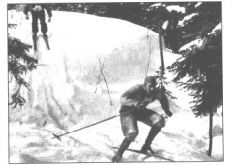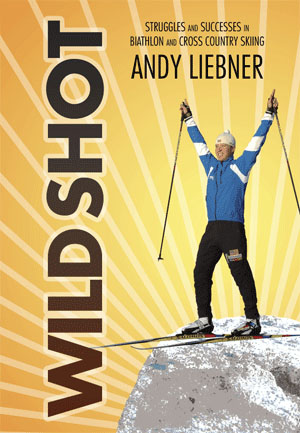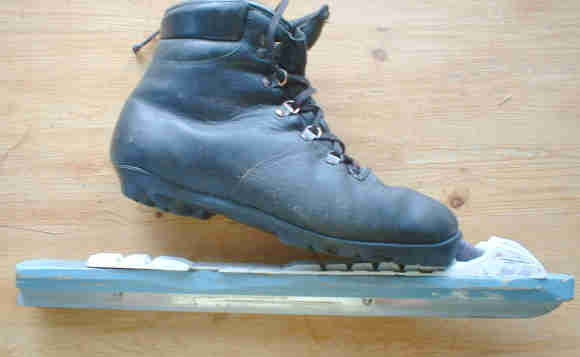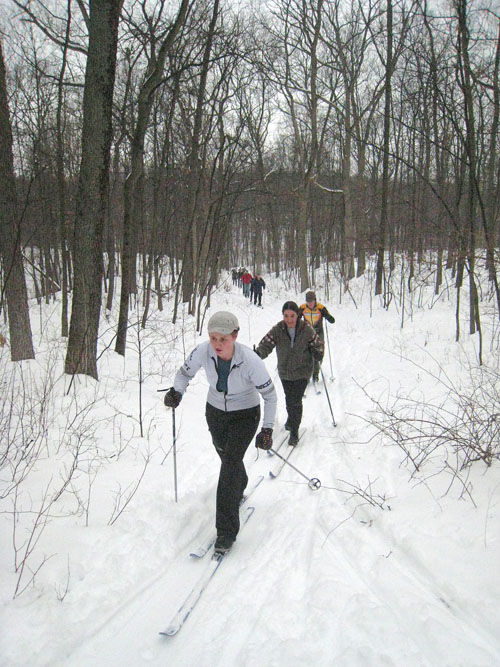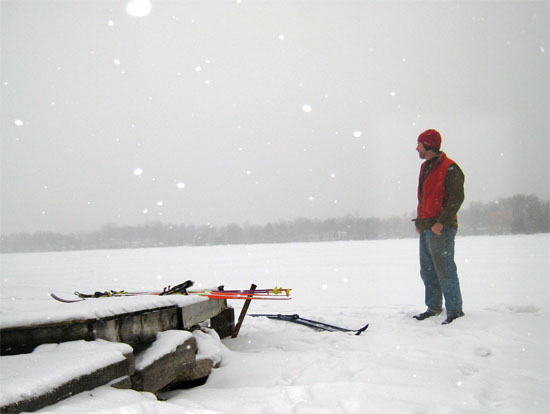[Just for fun I recast and distilled my huge ski-love essay into a tribute to homemade narrow-trail skiing. I did this because I think singletrack skiing is the most neglected aspect of XC today, by the media and by the official XC areas anyway. Of course, the bushwackers have been out there lovin’ it all along! –JP]
Mt-biking has its famous singletrack jones. Much less well-known is that XC skiing has it, too, in spades. It’s just not covered in the media or groomed for at official XC resorts. XC actually beats out the mt-bike: when threading a narrow course on skis you can pivot on a heel rather than have to guide a whole bike wheelbase.
So where do you find tasty XC singletrack? Just hit your fave bike singletrack when the snow flies! It’s not likely to be groomed, so ski it in yourself and use touring skis. Groomed ski trails are usually too wide and too tame to give the singletrack dyno thrill. But there are a few narrow or at least wild’n’twisty groomed trails still out there somewhere (there have to be). You can also easily make your own—just find a way thru the snowy woods and ski it in a few times. Instant trail! No enviro impact. Gone with the snow.
Bill Koch recently complained in a “Cross Country Skier” mag interview that handling skills aren’t pushed these days in XC, even on the WC level. I agree, though I suspect that skiing a WC course would still be a huge thrill! Before litigation-fear really sunk in (it hit in the early 80’s right when XC tried to take off) an expert-level groomed trail could be wild and challenging indeed. These trails have been greatly smoothed out since then, taking away the thrill and the imaginary lawsuit risk (why not just have a double-diamond grade so you can say they were warned). You basically have to ski-in trails yourself to get the real thing now.
To look at handling skills further, with XC you’re using the whole body and ideally use full abandonment as you throw yourself into the moves. You blast corners, catch air, your body parts tossed every which way by G-forces. You’re chest-first to the elements, flying down the hills, twisting the chutes, upright and exposed.
With singletrack in particular, you’re doing snaky body moves, sometimes pivoting your skis from edge to edge in a single move. Striding smoothly thru tight turns is an art: you don’t have to skate or skid all turns, you can glide right thru them by swinging your outside tail wide and timing pole-plants with whatever tree you’re dodging.
A dropping whoop-de-doo section of singletrack is amazing. Your little trail sends you flying and gliding over hummocks as you go down and down, turning left, right, with prejumps coming at you all the time, catching air here and there, sometimes barely keeping a ski on the ground to make the next turn. No need for a smooth straight downhill in the singletrack scene! (And no singletracker worth his salt would ever lay in a hard turn at the bottom of a hill like so many lame course builders do. When working small, you can work just right!)
Singletrack XC gets you close to the scenery. With XC equipment you’re so free that it’s no problem to bring a trail right between majestic trees, or so close to them that you have to drop a shoulder to miss em. It’s easy to squat way low to get under an overhanging limb, or jump a log, or even ski up and over one. You can even throw in a section that runs down a frozen creek, thru cattails and over a swamp or lake and back up into the trees. No worry about wide heavy grooming machines here!
XC offers range of action to beat the band. Everything on your bod is swinging and flinging far and wide. It’s so easy to time it all with obstacles. You can be rocketing along at, say, 15mph on one foot, chin out, shimmying thru the saplings.
XC is also like dancing. Keeping your Big Mo flowing through a course involves seamlessly changing up between all techniques, sometimes using a different move on each stroke, all in rhythm. In fact, in other languages the skating moves are called “dance,” as in “paddle dance” and “double dance.” XC is a big beat!
XC equipment itself offers a cosmic aspect: there’s no moving parts. OK, there’s one moving part, the binding, a minor thing. What you really have is a ski, with a flat bottom, and it glides like a skate with a razor edge. And you have pole-sticks. With those two one-piece goodies, a circus in the woods opens up to you.
Then there’s wax: in classic you have kickwax which when buffed isn’t hardly visible: yet it GRIPS. And when pushed it GLIDES! Glide wax is cool, too, in that, like kickwax, when you get it right it works so good. You can have rocketships (for both kick and glide, both uphill and down–4 different aspects!)….or you can have dogs…and the darn ski base looks the same either way. That’s a little weird. But if know your local snow and your wax you’re going to have fun.
In the winter, with no leaves on trees, trail vistas of every kind are opened WIDE. Summer has a close-in jungle feel. It’s great in its own way, of course, but there’s sweat, bugs, prickers, and nettles. Winter offers glide instead of rolling. And the air is so clean! What a nice time for a tricky dance in the woods.
Ski trails are where many sports meet. They’re the one place where bikers, canoers, runners, triathletes, hikers and bike-tourists all run into each other. Although the hikers and bike tourists probably have the most fun—they’re out with bread, cheese and winesacks, looking for interesting trails and sights—what workout? But everyone has a great time in their own way. Still, the smaller the trail the more the intimacy. So if we really want to build up our quality social time for on-trail hanging out, visiting and bumping shoulders, singletrack is where it’s at.
Then comes another joy: crust skiing! Springtime brings sunny melts and refreezes, for skiing or skating anywhere in the woods, dodging trees, flying over the lakes, leaping the fields, having a blast. It’s total liberation. A time of sunshine, suntans, wineskins, picnics—shorts and shortsleeves even. It’s singletrack everywhere! …Or is that highway skiing everywhere? How about both! Keep up with these concepts if you can. (If you haven’t tried it, or have only mt-biked before, your world is about to be opened up WAY big when you try XC skis.)
With XC all you need is gravity and a couple inches of snow, toss in a little hill and you’re set for fun. Add some narrow twisties and you got yer sweet singletrack to bring out your tricky moves. It doesn’t take much to keep a skier happy. I’ve been doing it for decades and I still enjoy it all. —On my mile of backyard and neighborhood trail.
It’s known that woods and mt-bike trails are cool in summer—compared to the parching heat of pavement. But it’s less known that woods are warm in winter. Moreover, the littler the trail, and the closer the trees and brush, the warmer and cozier you’ll be.
It may be that due to the heavy marketing of race-style stuff that some ski versatility has been lost or that people think that only groomed areas are good enough, even if they need to drive hours to get there. Groomed skiing is great. But so is every other kind. A track ski tends to be under 50mm wide. An all-terrain ski of, say, 58mm gives you float and glide in ungroomed snow but still works fine in groomed trails. That’s the ski I use most. It’s strong, too. I do jumps, and use em as bridges. No problem. Talk about free-ride! However, new things aren’t all bad: a recent innovation that’s really helped is the new generation of boots and bindings: they give control like never before. The recent shorty skis are also good things on narrow trails.
Singletrack culture is also so good looking, oh yeah. It’s thankfully overlooked by the glad-handers who design the garishly fickle racing stuff. So we get pretty things like that solid red Fischer touring ski: a classic beauty for all time. And since on homemade trail you might not be working out quite as hard, you can be freer to put together nicer looking outfits.
XC in general makes every part of you strong, flexible and longlasting. But a skier moves around so dyno on a narrow trail that when weird things happen, like crashes, we’re far less apt to get hurt or strained.
I like how the Europeans ski. It’s like how they ride bikes. They ride elbow to elbow, bumping around, leaning on each other to tell stories. When skiing they bunch together so they can chat—you’re tip to tail or if ski-skating your skis are meshed in with theirs, with your tips gliding up between their tails and your pole plants coming close to theirs. Yet they’re relaxed. That’s the secret. Relax, have fun, ski together. Younger skiers of this style clown around and do tricks willynilly as they ski. They might do a forward roll off a bank into deep snow or kick together a little jump on a downhill and go up and down a few times jumping and catching yards of air, landing in their best telemark. This togetherness is even more fun on singletrack.
Remember that singletrack trails, homemade or otherwise, are basically “leave no trace.” (Perhaps we forget how little impact XC had before extensive grooming and liability frets, even in races.) All it takes is a little vision as you cruise the terrain to see where a trail wants to be, to optimize flow, fun and handling skills. Then either just ski it in, or do a little pruning and dead limb tossing first. Of course, use common sense and conform to local regs, as best you can. The trimming that hunters can legally do for blinds and sight-lanes would apply to you, too. (Know what special plants look like in winter to avoid them.) You can often build singletrack almost at strolling speed. Come Spring melt it’s like no one was ever there. This can’t be appreciated enough: with XC singletrack there’s no such thing as erosion. To build XC singletrack you’re just making the opening and clearing nasties underfoot, nothing more. It’s fast, easy, noninvasive. Yet it gives you all the trail-love.
For an all-body workout and the rewards of totally maximizing handling skills and technique transition, try XC singletrack!
